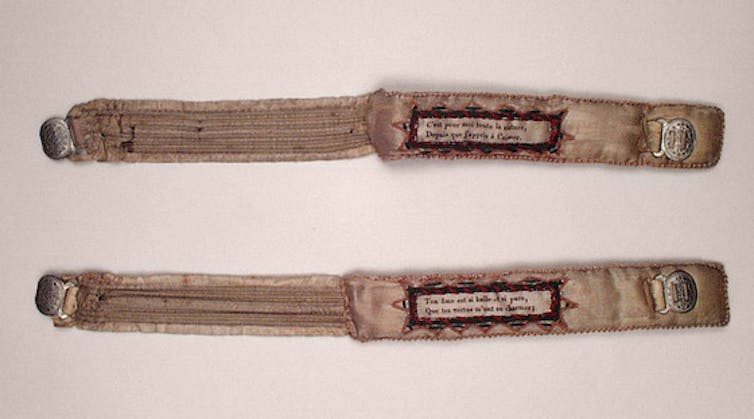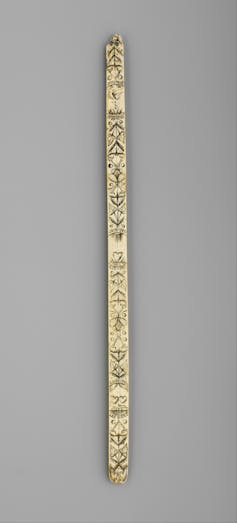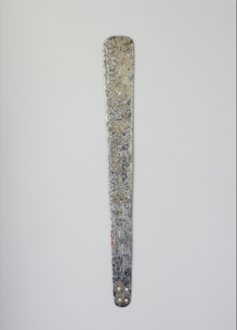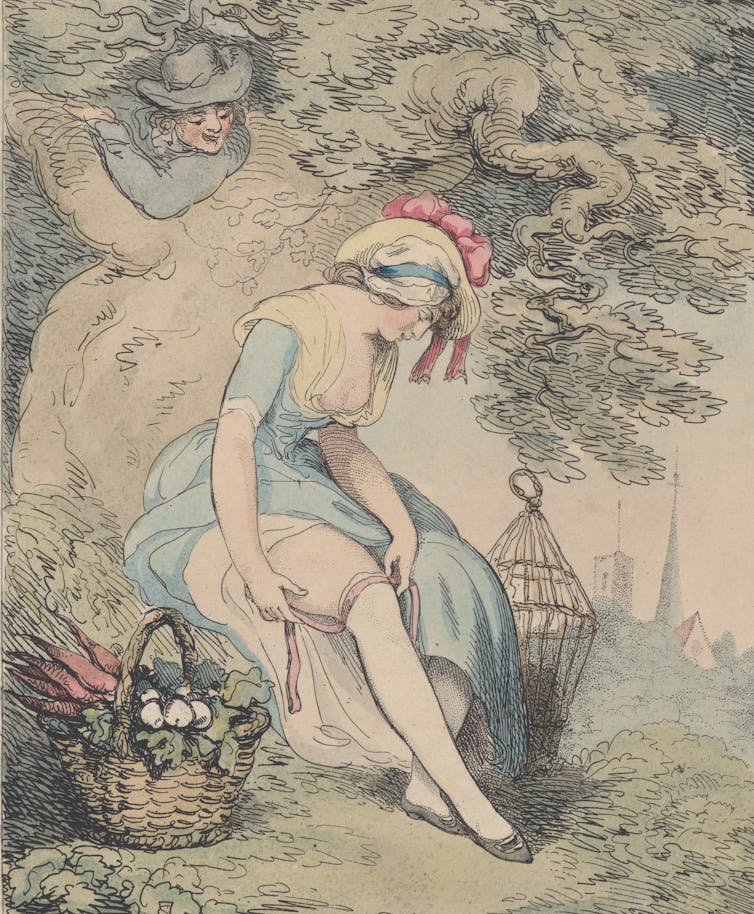garters and 'busks' inscribed with love notes were the sexy lingerie of the past
- Written by Sarah Bendall, Research Fellow, Gender and Women's Research Centre, Institute for Humanities and Social Sciences, Australian Catholic University
Lingerie sales in 2020 surged as pandemic lockdowns saw online shoppers seek to escape the mundanity of sweatpants and spice up their sex lives. Such sales will likely increase ahead of Valentine’s Day, but the gift of intimate apparel is not a modern phenomenon.
In 17th and 18th-century England and France, intimate objects were also gifted during courtship or amorous liaisons as tokens of romantic intention and sexual desire.
The “busk”, a long piece of wood, metal or whalebone, was placed into a stitched channel between layers of fabric in the front of corset bodices or stays.
And garters — more of a novelty item today — were strips of fabric or ribbons tied around a woman’s lower thigh to keep her stocking in place.
Both were often inscribed or embroidered with intimate words of love. They were also charged with erotic connotations due to their intimate position on the female body next to breasts, groins and thighs.
 A pair of women’s garters, England or France, early 19th century, made from
printed and embroidered silk, metal clasp, and coiled wire.
Los Angeles County Museum of Art
A pair of women’s garters, England or France, early 19th century, made from
printed and embroidered silk, metal clasp, and coiled wire.
Los Angeles County Museum of Art
Intimate tokens
In 1684, English poet and playwright Aphra Behn imagined a tree that for years had witnessed couples wooing under its branches. Her poem ends when the tree falls to the axe and …
My body into busks was turned:
Where I still guard the sacred store,
And of Love’s temple keep the door.
 This 17th-century busk is inscribed with a heartfelt poem, to be worn close to the bosom.
Gift of Mrs. Edward S. Harkness/The Met Museum, New York.
This 17th-century busk is inscribed with a heartfelt poem, to be worn close to the bosom.
Gift of Mrs. Edward S. Harkness/The Met Museum, New York.
As busks were destined to sit on the body next to the heart, it was only fitting that wood from this tree was used to fashion them.
Several plays and poems refer to men who bought or made busks for their sweethearts. The sheer number of surviving busks that contain inscriptions of love testifies to their popularity.
One 17th-century French busk in The Met Museum’s collection exclaims, “Until Goodbye, My Fire is Pure, Love is United”.
Three engravings correspond with each line: a tear falling onto a barren field, two hearts appearing in that field and finally a house that the couple would share together in marriage with two hearts floating above it.
Similarly, surviving 18th-century garters contain embroidered sayings and verses. One 18th-century French pair proclaims, “same hearts, same thoughts”.
Another states, “My motto is to love you, It will never change”.
In February 1660, meanwhile, Samuel Pepys noted in his diary that he sent his wife “silk stockings and garters, for her Valentines.”
Read more: Dear Valentine, take another little piece of my heart, or hair
Erotic puns
Although busks and garters were commonly given as gifts, even on Valentine’s Day they were not socially ostentatious tokens like jewellery.
Their position within or underneath clothing meant that while giving and receiving could be public, the wearing was a matter of intimacy. This was exploited in erotic literature and on the objects themselves.
 17th century French busk inscribed with love poetry. Gift of Mrs. Edward S. Harkness, 1930.
Metropolitan Museum of Art, New York
17th century French busk inscribed with love poetry. Gift of Mrs. Edward S. Harkness, 1930.
Metropolitan Museum of Art, New York
Some inscriptions found on busks spoke of men’s jealousy of the busks, giving these inanimate objects voices of their own.
A 17th-century French busk, engraved with a man’s portrait declares, “He enjoys sweet sighs, this lover / Who would very much like to take my place.” That “place” being between his lover’s breasts.
Like busks, garters also contained verses acknowledging their intimate place on the female body. A pair of French embroidered silk garters from 1780 proclaims, “United forever / I die where I cling.”
In this context, “where I cling” refers to a woman’s lower thighs, which were only accessible to those most intimate with her. It was also a euphemism for an orgasm.
The busk itself could also take on phallic connotations as it was likened to a lover’s erection in bawdy jokes.
 A Girl with a Basket and Birdcage Adjusts Her Garter. Thomas Rowlandson, c. 1785-95.
Thomas Rowlandson/Met Museum
A Girl with a Basket and Birdcage Adjusts Her Garter. Thomas Rowlandson, c. 1785-95.
Thomas Rowlandson/Met Museum
By the late 18th century, busks and garters became less personalised and began to be produced on a large scale.
They tell the tales of both fickle human hearts and also of a changing European culture that embraced and then commodified love and desire — much like many Valentine’s gifts today.
Authors: Sarah Bendall, Research Fellow, Gender and Women's Research Centre, Institute for Humanities and Social Sciences, Australian Catholic University





